Displaying items by tag: Tanit
Round Ireland Yacht Race 2014 - The Fat Lady Sings
#roundireland14 – Can there be any ocean race of similar length that offers intrigue, excitement, drama, joy and despair to the same extent that the Round Ireland does?
What about the tight finish that saw only 7 minutes separating winner Tanit from Ruth in second place. How about Cavatina, much fancied before and after the start, on the water leader for 450 miles before fickle winds relegated her to a finish outside the top five. Think of the cruel luck of Amazing Grace, valiantly fighting back after a start line collision that cost her two hours of actual time and at least three more from missing the tide, only to break her boom when she had largely eliminated the deficit.
After recognising the great achievement of Richard Harris’ Clyde based Sydney 36 Tanit, much sympathy is reserved for Liam Shanahan and crew aboard the J109 Ruth. On Thursday morning we said “With only 45 miles to go at 4am, the forecast suggests that Ruth will enjoy a fairly steady breeze of medium strength for the final fetch to the finish.” Talk about putting the mockers on it! 4 hours later the wheels came off Ruth’s wagon and it took her 4.5 hours to cover 10 miles as the wind fell away. She still made a valiant effort to get across the line, missing out on overall honours by just 7 minutes after 5 days of racing.
Congratulations Tanit, deserved winners of the 2014 Round Ireland Yacht Race.
For those of us living the race vicariously, the Yellowbrick tracker has contributed enormously to our enjoyment so kudos to Wicklow Sailing Club and the RORC for its supply. Roll on 2016!
RoundIreland14 – It has been a classic Round Ireland Race. Just about everything except a gale, and even then there was some gear-breaking wind in the latter stages. But mostly, the sun shone. Or at least, there was little or no rain until Friday. And even if the wind didn't blow nearly enough, even those on the smaller boats who had committed a week's holiday time to this very special experience found they stayed within their leave limits, though only just.
When Wicklow farmer David Ryan confirmed in May that he had chartered the Volvo 70 Monster Project for the 2014 Round Ireland Race starting June 28th, he was succinct in his objectives. The bottom line was to support the Care For Shane campaign, which is raising funds for his nephew Shane Horgan, who was brain-damaged in a serious assault in 2012.
With the foundation of the plan in place, the details could be filled in. The Volvo 70 chosen was Russian, built in 2008 by Green Marine of Lymington. Owing to a shortage of funds during the race itself in 2008-2009, she didn't compete in all the legs. But once that race was over, here was this fine big Rob Humphreys design seeking a purpose, with time available to bring her up to standard. And she'd a new commercially-minded owner who cheerfully re-named the boat Monster Project, and worked on the basis of scouting out fresh fields for competition, as the Volvo World organisation was moving on to a new generation of boats in the next race.
But for round Ireland racing with fund-raising a priority, Monster Project ticked all the boxes. Nevertheless, Farmer Ryan was very realistic in his objectives. For sure, he hoped he might break the race's course record, which is a very different thing from the open round Ireland mono-hull record. But if he harboured even the slimmest hope of winning overall on corrected time, he kept it to himself. Yet he clearly stated that the main race objective was to win line honours – "first over the line for Shane". And at 18:25:25 hours on Wednesday July 2nd in a brisk southerly off the Wicklow pierheads with the enthusiastic support of the home crowd, Monster Project did that very thing.
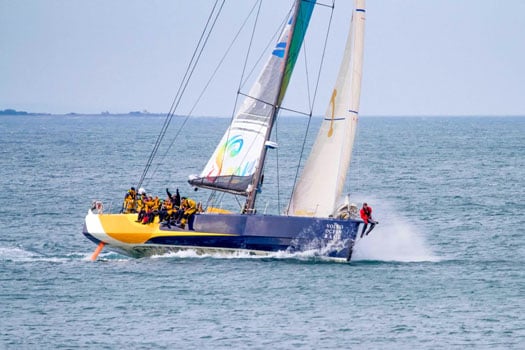
Job done. Monster Project takes line honours at Wicklow. Photo: Aidan Tarbett
As she was 70ft LOA and the next three biggest boats were "only" 60ft, it may have seemed a foregone conclusion. But the Round Ireland Race really is a case of swings and roundabouts and big dippers from time to time for every one of the 36 boats taking part. So though the Wicklow Monster may have built up a lead of 32 miles over the Open 60 Teng Tools Kilcullen (Eamon Crosbie & Enda O'Coineen) by the time she finished, she'd surely had to work for it. And had there been more fast off the wind stuff, things might have gone otherwise.
Despite the 10ft difference in length, the Open 60's potential is such that she rates an eye-watering 1.635 to the 1.6498 of Monster Project. So in rating terms the two boats were almost racing boat-for-boat, and in tactical terms that's the way Monster's 18-strong crew of all the talents had to see it.
But of course, with the predictions of light airs and calms for the first half of the week coming all too true, within 24 hours of the start it was becoming highly likely that one of the smaller boats would win, and low ratings became pearls beyond price. Observing it all and getting feedback from many sources, you became aware of the "Community of the Round Ireland Race" as the miles were slowly sailed. Their boats may have covered a wide variety of types and sizes, but the crews sharing this experience were joined together in a subtle way which gently but totally excluded outsiders.
You'd a sense of this in Wicklow as start time approached and the tension built up, with crews beginning to distance themselves from the shore crowds. Indeed, I got a blast of it in the car on the way down, listening to the Saturday morning's Down to Business programme on Newstalk, which is normally fronted by Bobby Kerr.
But as he was off to do the race on the fine big Farr 60 Newstalk for Adrenalin (chartered by Joe McDonald of the National YC), they'd a stand-in presenter. On the car radio, Kerr (a boat-owner himself) was trying to explain from the Farr 60 – with his usual zest – the special attractions of the Round Ireland Race to the American woman business journalist who was filling in for him in the studio. But he wasn't really making much progress. Her genuinely sceptical response to his enthusiasm for working coffee grinder winches and standing four hour watches 24 hours a day – and every chance of being called when you're off watch too – reminded me of the classic Bob Newhart sketch about the introduction of tobacco. The mutual incomprehension was just about total. And if Bobby Kerr can't explain the special attraction of racing round Ireland on his own radio show, then why do the rest of us even try?
The Round Ireland Race produces many imponderables. For instance, there's the matter of the new harbour and marina at Greystones finally hitting the headlines as a result of having Monster Project and Newstalk for Adrenalin based there in the leadup to the race, as Wicklow Harbour isn't really deep enough for them and both needed a pontoon berth.
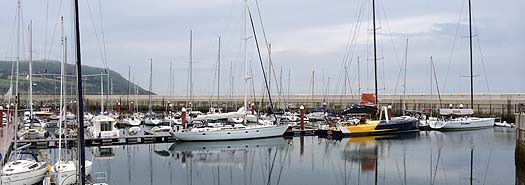
Arise, Greystones, and join the big time.....having Monster Project and Newstalk for Adrenalin in port pre-race raised Greystone's pofile something wonderful. Photo: Alan Corr
So Afloat.ie posted a pic from Alan Corr of Greystones Harbour showing the two biggies in port, and by sailing website standards it went viral. All because it's hashtagged #greystones. So be warned, in future you may find some very sleepy stories #greystones here on Afloat.ie if we hope to get them the Monster Newstalk level of attention.
But enough. Just as the sailor/spectator divide was beginning to manifest itself, I managed to get myself on board Wildwood for a quick recce. Not only was she the shortest entrant at just 30.5ft, but she was the newest with a build date of 2012. Yet in truth she was building since 2003, as this has been an extraordinary amateur design and build project, a case of good work done by stealth.
Though Wildwood sails from East Antrim Boat Club on Larne Lough, the first gleam of a notion came in the bar at Carrickfergus SC. Over a pint or three, amateur designer Richard McClure and can-do potential owner Ian Patterson sketched out ideas for a handy little dream performance cruiser-racer.
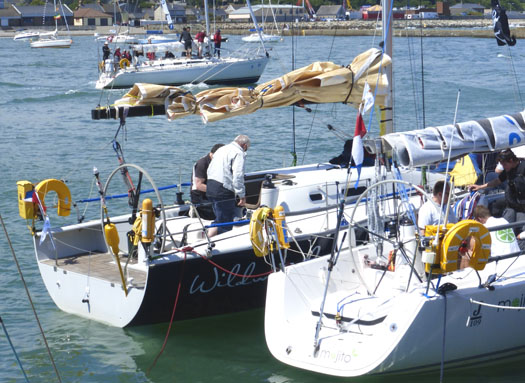
Little self-build 30-footer Wildwood (seen here outside the J/109 Mojito) came down from Larne to Wicklow for her first stab at the IRC big time. Photo: W M Nixon

Ian Patterson built Wildwood between 2003 and 2012, and they've won their class in the Scottish Three Peaks Race Photo: W M Nixon

Wildwood brought her shore support team – they came down from Larne with a couple of camper vans Photo: W M Nixon
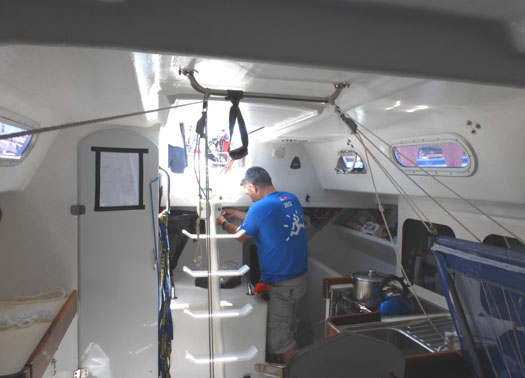
Below, Wildwood is roomy, with a highly individual layout Photo: W M Nixon

Wildwood has a substantial galley which wouldn't look out of place on a 40 footer. Photo: W M Nixon
It will be a good story to flesh out in more detail during the coming winter. Sufficient to say that she was launched in 2012 and arrived in Wicklow in June 2014 with honours already achieved by winning their class in last year's Scottish Three Peaks Race.
Nevertheless, despite the cheerful quayside support of family and friends who have stayed with the Wildwood project through its long gestation, the mood aboard was a bit subdued. The Scottish race had been on very basic handicaps, but the Round Ireland – which itself started in 1980 using a Wicklow modification of the ECHO system – is now part of the RORC programme, using strictly regulated IRC.
This new measurement routine put little Wildwood up from her notional rating of 1.02 to an official rating of 1.045. That may not seem like a huge jump, but for the crew of a little boat which prefers fast offwind stuff yet was going out to face a long beat right up Ireland's long Atlantic seaboard, it seemed like yet another mountain to climb.
But out they all go for the start, these 36 boats in all shapes and sizes, and any crewmember who denies abdominal butterflies at this time is either in denial, or so full of Stugeron they don't know what's going on below their navel.
With a decent nor'east breeze and a sluicing ebb running south, it's a tricky close reaching start at 1400 hours, but Teng Tools Kilcullen and serial overall winner Cavatina (Ian Hickey) are right there on time, and the only shunt in the body of the fleet is between western boats Lynx Clipper (Galway) and E F Collins/Amazing Grace (Tralee), with the latter returning to port to fix a fist-sized hole in her stern and set out again after some hours with a post-race protest in the offing.
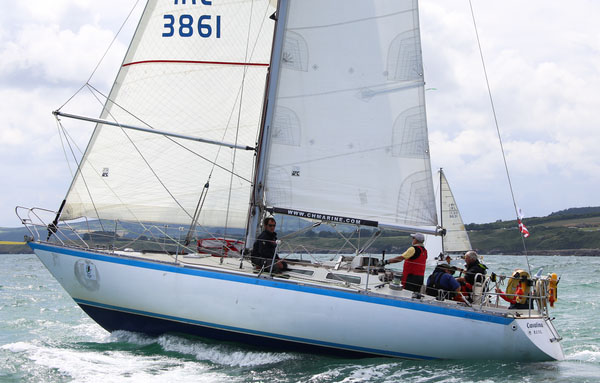
Out of the ruck of the start, the little Cavatina showed well among a raft of larger boats. Photo: David O'Brien
Coming out of the start, with boats which would emerge as performers as the race went on starting to show themselves. The Sydney 36 Tanit is left foreground, the Rodman JV 42 Phosphorus (Mark Emerson) is making hay with Code 0, the "steady Eddy" Ker 39 Inis Mor is right front, and the big Farr 60 Newstalk for Adrenalin is starting to show a performance which just kept getting better throughout the race. Photo: W M Nixon
Thanks to the Yellowbrick plotters, following the fleet has become like a computer game. If you're bored with the progress, you can always accelerate them electronically up and down along the course, with it all becoming – as the less reverent have remarked – like a pack of rats trying to get up a drainpipe.
It's when you see it reduced to symbols on a screen in the big picture that you realise how restrictive the round Ireland is for epic tactical gambles. In the Newport-Bermuda race, for instance, the 600 miles of straight line across the open ocean provides a broad canvas, and the famous Carina once notched one of her legendary wins by being all of 60 miles to the westward of the rhumb line. But in the round Ireland, only along the south coast is there a decent option for taking a real flyer, and it was there south of Youghal that Teng Tools went offshore as the wind drew sou'westerly, while the nearby and faster-to-windward Monster Project went off to close the land and cover the French Volvo 60 Libertalia and Newstalk for Adrenalin.
Monster put those two well away, but at the Fastnet she was only 20 minutes ahead of Teng Tools Kilcullen shortly after noon on Sunday, TTK coming sweetly in from seaward and doing very well in conditions which didn't really suit her at all.

Teng Tools Kilcullen at the Fastnet 21.5 hours after the start. Photo: Paul O'Flynn
In fact, if you'd set out to design a race which didn't at all suit an Open 60, then the 2014 Round Ireland would be in the top five. An awful lot of light windward work, and gates at every turn. In these conditions, a Volvo 70 is more flexible, but even so on Tuesday as Monster sat stopped off Inishtrahull, TTK was close to the southwest and energetically tacking inshore along the north coast of Donegal against a local easterly, keeping herself well in touch.
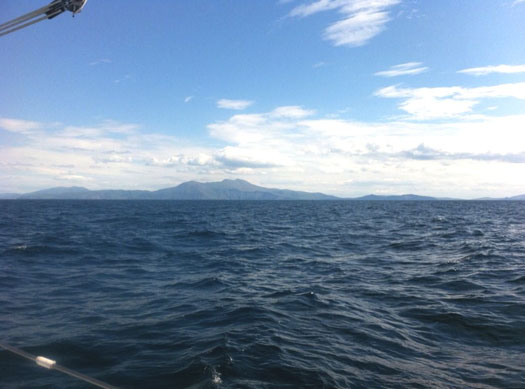
Fine day out west – the Kerry coast with the Blaskets as seen from Liam Shanahan's J/109 Ruth

Good morning, Ireland. The Scottish Sydney 36 Tanit (Richard Harris) enjoys a summer sunrise on the Atlantic coast, even if they do have to turn to windward. Photo: Roisin Harris

Even with all June's sunshine, the North Atlantic was distinctly chilly for this swim from the First 40 Arthur Logic

Downtime on the Sydney 36 Tanit out in the Atlantic. Owner Richard Harris sails under the burgee of the Serpent YC, a Scottish club founded in 1976 for sailing health professionals. Photo: Roisin Harris
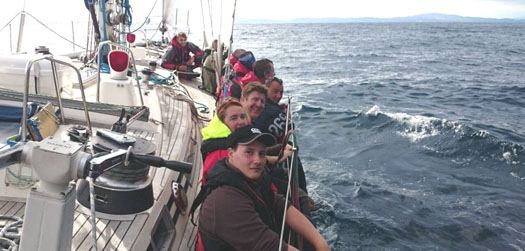
All hands to the lee rail to get a bit of heel on the hefty Swan 57 Bow Waves Racing from Galway as she makes slowly to windward off the Atlantic coast.
The two biggest boats then had an awful lot of hard work tacking through the North Channel, but astern Newstalk was getting into the groove, and by the time Monster was finishing the Farr 60 had seen off the Volvo Ocean 60, and was giving TTK a bad time.
With the new southerly filling in with gusto, the little boats still off the Donegal coast were making hay, with Cavatina coming in round Tory Island well up with the Swan 57 Bow Waves from Galway. Cavatina's crew were having the time of their lives and living well with it – they tweeted the cooking spuds which power the boat, presumably with buckets of Barry's tea. However, until Donegal the talking point had been the impressive game of catch-up being played by Brian O'Sullivan and his Tralee Bay crew in the Oyster 37 E F Collins/Amazing Grace, as they were ninth overall in IRC at one stage, and of course if their protest was upheld post-race, Heaven only knows what compensatory time would be added.
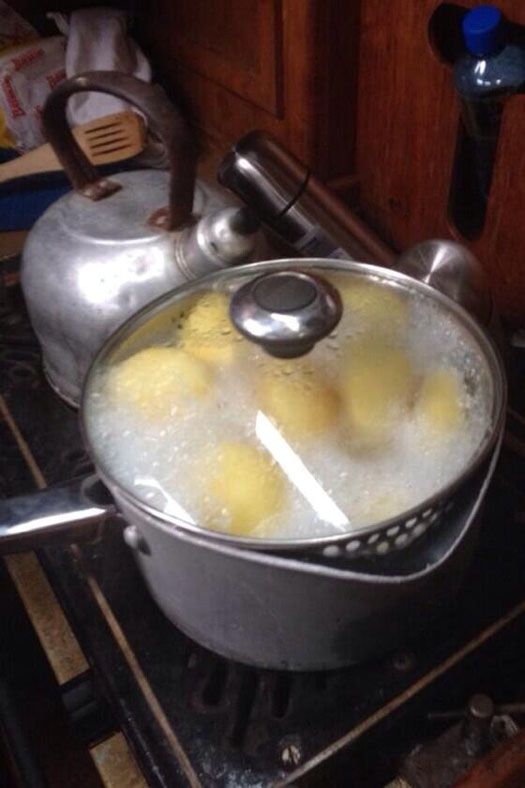
Grub up! In many years of successful Round Ireland racing, Cavatina's crew have learned the importance of feeding the inner man.
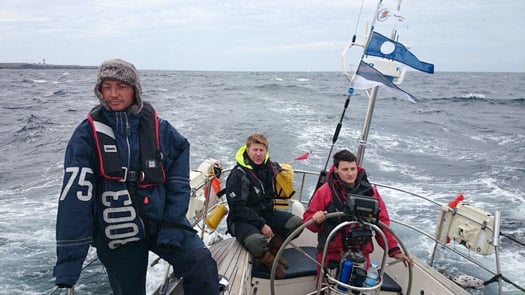
The brisk new sou'wester brought the Swan 57 Bow Waves Racing sweeping in past Tory Island, but she'd the much-smaller Cavatina in sight astern.
But that spirited performance ended with a bang on Wednesday with a broken mainboom which, together with other problems, led to their withdrawal. However, there were plenty of others to take their place in challenging for the overall lead, with Liam Shanahan and his crew from the National YC in the J/109 Ruth getting themselves firmly ahead of Frank Doyle's A 35 Endgame from Cork, while the attractive Sydney 36 Tanit from Scotland was also very much in the running.
Looking at the fleet overall as they made along the Donegal coast, there were discernible patterns emerging, with boats you'd call the "solid performers" starring on the track chart. These were boats such as Inis Mor, Tanit and Ruth which always seemed to be there or thereabouts, always plugging away and showing a clean pair of heels to the nearest-rated boats, and always well placed such that if local wind and tide conditions favoured them, they were poised to ascend rapidly to the top of the leaderboard.
As for the "sail training" vessels, in the closing stages the Jeanneau Sunfast 37 Desert Star of Irish Offshore Sailing at one stage on Wednesday found herself lying second overall to Cavatina. But with 170 miles still to go, and most of them to windward, it was going to be hard work for a keen multicultural crew of many nationalities to maintain this exalted placing.
It was Thursday morning which was crunch time. Having filled in from the south, there was a brief period in which the wind veered towards the west, and with Monster Project well finished and then Teng Tools Kilcullen, Newstalk for Adrenalin and Libertalia finishing during the night, first light saw the steady and reliable Inis Mor finishing at 04:13:56 to stake a claim which was challenged by boats such as Tanit and Ruth closing up from astern in a now-favourable tide, the tide having been against Inis Mor all the way down from Rockabill except for the last hour or so.
The challenge from a hundred miles away of Cavatina faded for a while with light airs off Belfast Lough and a foul tide in the North Channel. But in the south end of the Irish Sea and through St George's Channel, the sou'west to west breeze was holding enough to have Tanit and Ruth moving theoretically into the top slots ahead of Inis Mor. But then with the tide turning again to run north around 0900 hrs, it was to be nail biting stuff through Thursday morning.
Tanit was in by 10:00:44 hrs on Thursday, leaving the lower-rated Ruth with a mountain to climb, the tide against her and the breeze light. It was excruciating to follow, with her speed down at times to barely a knot over the ground off Greystones, and the lovely Wicklow coastline just crawling past at snail's pace. Meanwhile, far astern Cavatina was back in business with just 80 miles to sail, and a local breeze giving her better than 5 knots on the clock.
Meanwhile by 1300hrs Ruth had just 5 miles to go, and speed slowly building as the wind was generating around big clouds over Dublin.
But by just after 2pm Thursday it was clear Tanit had pipped Ruth for the clubhouse lead. Ruth had looked all set to be the leader until a cruel combination of decreasing wind and increasing adverse tide held her up within sight of the Wicklow finish. Tanit, safely in the club, knew that any setback to Ruth's progress would establish them as the target boat for the rest of the fleet. Wicklow Sailing Club could not formally announce the winner until much later on Friday as the last of the boatts finished but it was clear not even Cavatina who had until 2am on Friday could match the time of the Scottish Sydney 36.
They and all the other competitors will have this weekend to decompress and try to explain to family, friends and workmates just what this crazy Round Ireland Race thing is all about. But it isn't until the great prize giving dinner in Wicklow in the Autumn that they can all really tell the stories that just have to be told, and tell them to people who will really understand.
























































